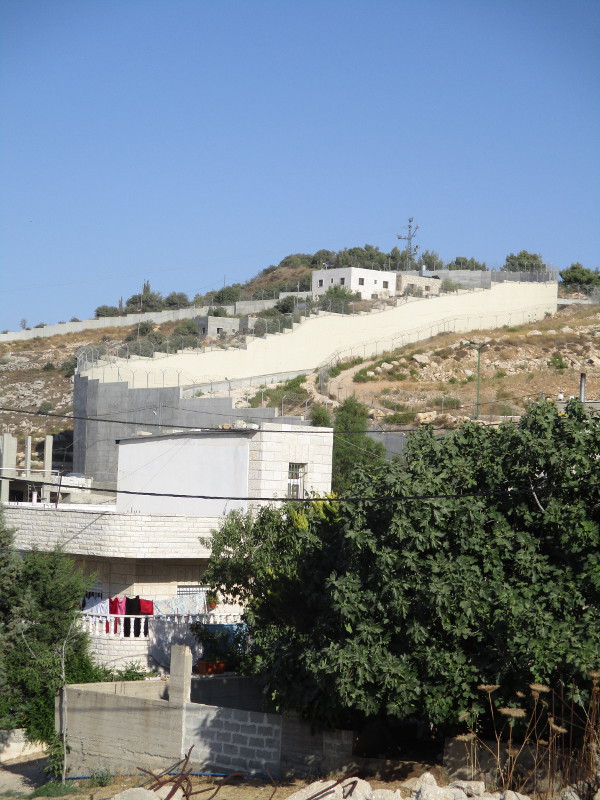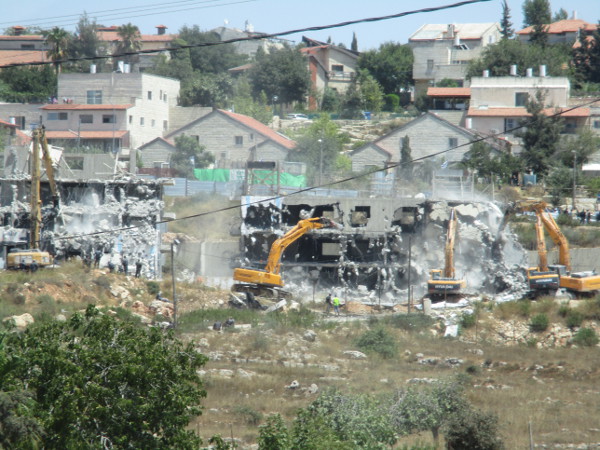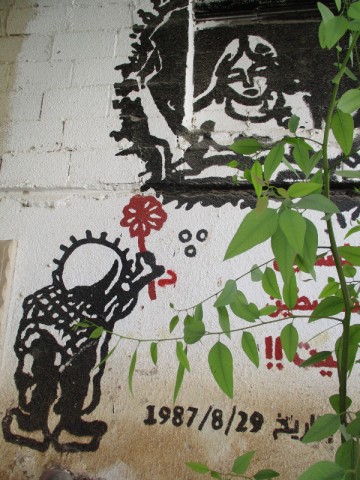A guest post from Lisa Tilley. Lisa is a GEM Doctoral Fellow at Warwick and ULB. Her research has taken place in sites of extraction (urban slums and rural settlements) in Indonesia and draws on political ecology and political economy, as well as postcolonial and decolonial thought. An earlier version of this post is also available at the wonderful new resource that is Global Social Theory.
If this farm had not been ravaged
I could have become an olive tree
or a geography teacher
or an expert of the kingdom of ants
or a guardian of echoes
– From Mahmoud Darwish’s The Dice Player (visual version here)
Writing/Speaking/Thinking the Global Palestine
The settler colonial condition can be fully understood only by those who live it. But the rest of us can at least bear witness in the place (Palestine) where it is most legible.
Since the Nakba (catastrophe) of 1948 when 800,000 Palestinians were expelled and 536 towns and villages were deleted from the map the fast and slow erasure of Palestine has continued as an active political project.[1] Zionist leader Chaim Weizmann encapsulated the unrelenting strategy of everyday dispossession in the phrase: “another goat and another acre”.[2] This has been paralleled too by fast and slow memoricide, the deleting of the artistic, historical and cultural existence of Palestine.[3] Tahrir Hamdi calls these the “two movements” of erasure, the cultural and the material.[4] Two movements working not towards the goal of Palestine no longer is but towards the goal of Palestine never was.
Doing a geography conference (ICCG) in Ramallah was therefore an organised act of defiance against Palestinian erasure (“Welcome to Palestine […] its geography lives”).[5]
There was no veneer of political neutrality to this event and participants, just by being there, were ascribing to an explicit pro-Palestinian position which is best left in the words of the organisers themselves:
The power asymmetries and injustices that define this context entail difficult choices but also present a need to position oneself politically; Palestine is not an abstract geography where a conference can take place above politics. As such, everyone registering and attending this conference is considered as standing in support of three basic Palestinian rights, stipulated in international law. That is, ending the occupation of the Gaza Strip, the West Bank including East Jerusalem, and the Golan Heights; recognizing the fundamental rights of the Arab-Palestinian citizens of Israel to full equality; and respecting, protecting and promoting the rights of Palestinian refugees to return to their homes and properties. […] In recognizing these Palestinian rights and siding with the oppressed, the conference avoids giving a false impression of normalcy in a context defined by settler colonial oppression and racial discrimination.[6]
Yet in spite of the overtly political and defiant tone, the organisers[7] had agonised over the decision to hold the event in the West Bank because doing so effectively excluded most Arab and Muslim scholars from other parts of the world, as well as Israeli allies who are prohibited from entering Palestinian urban areas, lest Israeli-Palestinian solidarities bloom. Some registered participants were turned away by border forces after being interrogated upon arrival at Tel Aviv, others, especially those with links to Arab or predominantly Muslim countries were subject to invasive interrogation and humiliation either on arrival or on departure.[8]
Yet even these denials, sacrifices, indignities, and border dramas, much as they caused individual pain, actually served in their own way to fortify the overall political message of the conference by becoming part of the anti-normalcy performance of the event itself. Beyond this, physically being in the ‘critical’ geographies of the West Bank was politically and intellectually productive in a way that would be impossible to recreate in another time and place.
Palestinian scholars and others for whom Palestine has been a long-time focus were given a central platform from which to communicate their work, while those of us working within other geographies elsewhere inevitably brought Palestine into comparative relief with the places we study. The effect was one of writing/speaking/thinking the global Palestine into being; in this sense echoing the long-time endeavour of Palestinian scholars, artists, writers, and poets like Darwish who have sought both to write Palestine back into existence, building a “country of words”, and also to “write back to those narratives that have intentionally falsified history”.[9]
Palestine exists anyway of course, regardless of who takes up a pen to sketch its representation. We know this now because in the spaces we witnessed, from Ramallah to Nablus to Bethlehem, to the refugee camps of Dheisheh and Aida, and in all of the asphyxiated villages in between, we felt its beating heart and traced the racing flow of its veins.
We now understand better the words of Rafeef Ziadah when she says: “We Palestinians teach life after they have built their settlements and apartheid walls, after the last sky; we teach life, sir.” The visceral peace of communal life in Palestinian spaces, and the warmth and spirit of Palestinian people evoked a sense of contentment in each of us (“We Palestinians wake up every morning to teach the rest of the world life, sir”). And yet, the violence of occupation is ever-perceptible. It stands there at your back, looms in your peripheral vision like a concrete wall, interjects into the day through news reports, through grinding scenes of injustice, through recounted past and present stories of brutality. This is the essence of the dissonance of occupied Palestine: peace and spirit walled in by brutal violence.
Material Conversations
To move around the West Bank is to witness the concrete advance of Israel through the constructions which form the material instantiation of its foundational racism. The freakish built matter of the concentration camp (walls, wire, watchtowers) is echoed here but takes on a meandering form, snaking its way in curves and angles across the butchered landscape. And this built matter of the colonial condition voices its conversations materially:
“Concrete, why bully me?
Have you forgotten what you are composed of?”
“Sand, why get under my skin?
Have you forgotten how I erase you?”
The Zionist Benny Morris once referred to ‘caging’ the ‘wild animal’ in Palestine, and now Palestine in the West Bank has become confined within over 220 separate ‘cages’ constructed mainly from the now-emblematic barbed wire-adorned eight metre walls. Like a fish trap, the connections between walled spaces can easily be shut down by closing the gates at checkpoints, isolating those inside the cage.
We visited villages and spoke to residents about the walls that close in around them, seal off their existence, asphyxiate their lifeworlds. And Darwish too narrated the lived experience of this project of erasure by describing it as an ever diminishing space. Erasure for Darwish is one of volume rather than area, the body is surrounded by earth rather than air:
Earth is pressing against us, trapping us in the final passage
To pass through we pull off our limbs
Earth is squeezing us. If only we were wheat, we might die yet live
If only it were our mother so she might temper us with mercy
If only we were pictures of rocks held in our dreams like mirrors
We glimpse faces in their final battle for the soul, of those who will be killed
by the last living among us. We mourn their children’s feast.
We saw faces of those who would throw our children out of the windows
of this last space. A star to burnish our mirrors.
Where should we go after the last border? Where should birds fly after the last sky?
Darwish talks of pulling off limbs in order to fit in the reduced spaces of existence, and as we move through the West Bank, we see how the body of Palestine itself has become a series of fragmented parts.
Leaving Ramallah for a field trip, the news interjects again: “Israel takes control of illegal West Bank homes: Israeli forces clash with Jewish settlers after taking over buildings.”
And travelling by, we see those token West Bank settler constructions being torn down on the outskirts of Ramallah at Beit El. We watch the arms of the bulldozers scratching like cats at the settler buildings, while the baying crowd on the hill draws out its violent protest. A great spectacle indeed, but the demolitions are less than a graze on the rapidly advancing stone boots of Israeli settlements. And of course, the following day a ‘price tag’ arson attack on Palestinian homes in Duma takes the life of 18 month old baby Ali Dawabsheh, another child thrown “out of the windows of this last space”.
Back in the classroom, a Palestinian scholar recalls the story of another baby, whose mother had rushed to Jerusalem on the bus, trying to delay the birth of the child until she crossed into the city to endow the infant with the Jerusalemite ID. “I was giving birth” said the mother “but living death at the same time”. The bodily performance of labour in her case involved crossing a concrete material divide and pushing through walls in order to bring a life into being on the ‘right’ side of an epistemic division.
“We do not need pity”
In Bethlehem we visit the UNRWA refugee ‘camps’ of Dheisheh and Aida – with the scare quotes here intended to disturb the implied temporalities of the camp. These are established places, places of intergenerational permanence for Palestinians, many of whom are born and die as ‘refugees’ with no right of return. But these are also sites of organic organisation, of community support and protest. From the ‘camp’ unfolds a distinct form of immanent politics, through which committees build alignments across political divides and under the common and unifying conditions of abjection. Camp walls are adorned with staggering murals, communicating and interpreting the colonial condition. The emblematic figure of Handala – named after the bitter plant al-handal, signifying the bitterness of the Palestinian experience – appears alongside the women who always accompany him to signify their position in “the thick of the struggle”.[10]
The academic conversations continue in our classroom spaces. We talk about materiality, the decolonial, the corporeal, about Marx and Lefebvre, Fanon and Said, about gentrification, dispossession by speculation, urbicide, memoricide and pinkwashing. But Palestine always stays on our lips, confronts our concepts and categories, even rendering worthless some of our carefully spun arguments. The real lessons took place in fertile valleys, poisoned by settler toxins, alongside the walls in which blast holes remain, at the sites of shootings and repressed Selma-style marches, witnessed by nobody (“why don’t you Palestinians try non-violence? Ha! Well, we’ve done much more than Ghandi marches!”[11])
There were moments when we all simply turned our faces away and wept. But the tears of three hundred critical geographers falling on Palestinian soil will not bring down walls or shatter a violent racist project. “We do not need pity” was stated from the start by Palestinian scholars. So instead the task is to bear witness to Palestine, to say that we know Palestine, that we know it exists, that it has existed, and will continue to exist. Palestinians continue the process of writing back, we can only echo what they say and join in the task of writing/speaking/thinking back in order to bring into being a global Palestine.
Reading
Fields, G. 2012. “This is our land”: Collective Violence, Property Law, and Imagining the Geography of Palestine. Journal of Cultural Geography 29(3): 267—291.
Hamdi, T. 2011. Bearing Witness in Palestinian Resistance Literature. Race & Class 52(3): 21—42.
Said, E. W. 1986. After the Last Sky: Palestinian Lives. Faber and Faber.
[1] Esber, R. 2009. Under the Cover of War, the Zionist Expulsion of the Palestinians. Arabicus
[2] Said, E. W. 1986. After the Last Sky: Palestinian Lives. Faber and Faber, p. 101
[3] Pappe, I. 2007. The Ethnic Cleansing of Palestine. Oneworld Publications.
[4] Hamdi, T. 2014. Darwish’s Space, Place, and Identity: Under Construction. Conference presentation Second Bremen Conference on Language and Literature in Colonial and Postcolonial Contexts (BCLL #2), 3-7 September, 2014.
[5] The words of a Palestinian scholar (name withheld) on the first day of the conference.
[7] The names of the organisers and local Palestinian scholars involved in this event are withheld here in case of repercussions.
[8] Holgerson, S. “I was going to a conference”
[9] Hamdi, T. 2014. Darwish’s Space, Place, and Identity
[10] Hamdi, T. 2011. Bearing Witness in Palestinian Resistance Literature. Race & Class 52(3): 21—42.
[11] As stated by a resident of Nablus, July 2015




Reblogged this on oshriradhekrishnabole.
LikeLike
Pingback: Bearing witness | geographical imaginations
Pingback: The Political Ecology of Everyday Life under Settler Colonialism I – Reporting from Palestine | ENTITLE blog